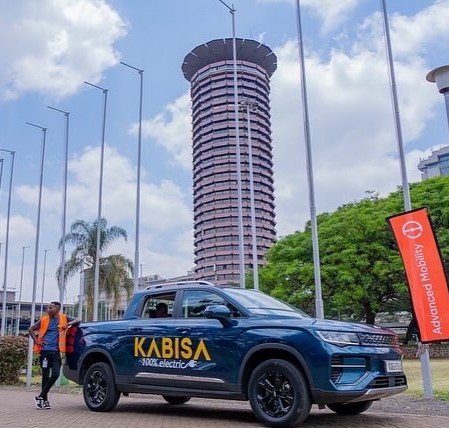In September 2024, the Kabisa team led by Marumbo Sichinga, Business Development & Sales Lead, undertook the first-ever electric vehicle (EV) road trip across East Africa, driven by Sales Associate, Rodrigue Mucyo; traveling 2,400 kilometers from Kigali, Rwanda, to Nairobi, Kenya and back to Kigali with the Radar RD6 electric pickup sold by Kabisa. It took two days, both ways. This journey not only confirmed the durability of EVs for long-distance travel but also highlighted the growing EV infrastructure in the region. Let’s dive into the details of this significant trip, examining the vehicle’s performance, charging infrastructure, and operational challenges faced along the way.
Vehicle Specifications: The Radar RD6 Pickup
The Radar RD6 electric pickup sold by Kabisa is designed for endurance, with an impressive battery range of 410 km on a full charge. It features a GB/T charging port, allowing compatibility with various charging stations across the region. Here are some key specifications that contributed to its performance during the trip:
- Battery Capacity: 63 kWh
- Range: 410 km (CLTC depending on driving conditions and load)
- Payload Capacity: 550 kg
- Charging Compatibility: GB/T (DC fast charging and AC charging)
- Acceleration: 0-100 km/h in approximately 8 seconds
- Onboard Charger: 7 kW AC (Level 2 charging capability)
- Onboard Generator: In case of a serious emergency
Journey Breakdown: Charging Stops and Efficiency
- Kigali to Mbarara
Distance: 300 km, 4 hrs 30 mins to Rubis station in Mbarara
Percentage left upon arrival: 31% that can travel 129kms
Initial Charge: Full charge from a Kabisa 30 kW DC fast charger at SP station in Kigali
Challenge: Upon arrival in Mbarara, the team encountered a lack of public charging infrastructure. They attempted to use a portable generator but faced technical difficulties, resulting in a breakdown. Instead, they sourced local assistance to connect their 7 kWh charger to a distribution box at a Rubis gas station, charging overnight for approximately 8 hours.
- Mbarara to Kampala
Distance: 200 km, 5hrs
Percentage left upon arrival: 22% that can travel 92kms
Charging Stop 1: AC charger from EV World, managed by Robert Wakabi
Charging Time: 3 hours (approx.)
Charging Stop 2: City Oil DC fast charger
Charging Time: 1.5 hours to a full charge at 35 kW
The team leveraged the support of local EV advocates, emphasizing the importance of community in developing the EV landscape in Uganda. The fast-charging capabilities at City Oil allowed them to replenish quickly, demonstrating the practical usability of the vehicle.
- Kampala to Jinja, Jinja to Kisumu
Distance: 175 km to Jinja, 3hrs.
Distance: 234 kms, 4hrs 30mins
The team attempted to charge in Jinja, but logistical issues prevented successful charging. Upon arriving in Kisumu, they accessed a 7 kWh charger through EV Chaja. This stop involved a charging time of approximately 6 hours, a testament to the varying availability and speed of charging infrastructure.
- Kisumu to Nakuru
Distance: 160 km, 3hrs
The charging stop in Nakuru highlighted the growing EV infrastructure but included odd regulations, with guards imposing time limits. Nevertheless, the team managed to charge adequately, allowing them to proceed to Nairobi.
- Arrival in Nairobi
Final Distance to Nairobi: 147kms, 2hrs 40mins
Upon entering Nairobi, the Radar RD6 pickup underwent final charge stop at BasiGo, using a GB/T fast charger to ensure it was fully charged for city driving.
The return trip back to Kigali was equipped with more knowledge which earned quicker charging stops and a smoother journey through the same 4 towns and cities. It took an average of 2 full days both ways for this successful trip.
Comparing Emissions and Costs: Toyota Hilux vs. Radar RD6 on a Road Trip from Kigali to Nairobi
As electric vehicles (EVs) gain popularity, it’s important to assess how they compare to traditional internal combustion engine (ICE) vehicles, especially on long road trips. Let’s take a look at the popular 2023 Toyota Hilux diesel and the Radar RD6 electric—to highlight the cost-effectiveness and environmental impact of going electric for a journey from Kigali to Nairobi (approximately 1,200 kilometers one way).
Fuel Consumption and Emissions: Toyota Hilux
The 2023 Toyota Hilux diesel is a popular choice among pickup owners in East Africa due to its durability, rugged design and fuel efficiency. For this 1,200 km trip, the emissions and fuel costs are calculated based on typical fuel consumption:
- Fuel consumption: 8 liters/100 km (diesel)
- Total distance: 1,200 km
- CO2 emissions per liter of diesel: 2.68 kg
- Total fuel used: 96 liters
- Total emissions: 96 liters × 2.68 kg = 257 kg of CO2
- Total Diesel Cost (96 liters):
- Rwanda: 156,384 RWF ($111.70)
- Uganda: 489,600 UGX ($129.60)
- Kenya: 18,624 KES ($125.10)
Radar RD6 Electric Pickup: Efficiency and Costs
The Radar RD6 electric pickup is gaining ground as a strong competitor to ICE vehicles like the Hilux. Here’s how it performs over the same journey:
- Battery capacity: 63 kWh
- Range per charge: 410 km on a full charge
- Energy consumption: 18-20 kWh per 100 km
- Total energy needed for 1,200 km:(20 kWh100 km)×1200 km=240 kWh(100km20kWh)×1200km=240kWh
Charging costs vary, but for EV charging in;
- Rwanda: with Kabisa public chargers: average cost is Rwf 94/kWh, full charge is Rwf 6,016
- Uganda & Kenya: Prices typically range between $0.05 and $0.10 per kWh; Average cost for a full charge is $6.30
For the 1,200 km journey, the Radar RD6 will needed 4 charging stops, not from 0%:
- Total charging cost: $25-$27 dependant on the charger provider
Cost Comparison
Here’s a breakdown of fuel versus charging costs across the three countries:
- Toyota Hilux Diesel:
- Rwanda: $131.90
- Uganda: $129.60
- Kenya: $125.10
- Radar RD6 Electric:
- Across the board: $25
This means that by driving the electric Radar RD6, you could save between $106.70 and $100 on fuel costs alone, depending on the country.
Emissions Comparison
The environmental impact is equally significant. While the Toyota Hilux emits approximately 257 kg of CO2 one way over the 1,200 km trip, the Radar RD6 produces zero tailpipe emissions. By choosing the Radar RD6, the driver would eliminate all tailpipe emissions for this journey, further reducing their carbon footprint.
The Impact of Going Electric
The Radar RD6 electric pickup offers substantial cost savings and environmental benefits compared to the Toyota Hilux diesel. While diesel remains a common fuel choice, the growing availability of EV charging infrastructure and the lower operating costs of electric vehicles make them an increasingly viable alternative, particularly for long-distance travel. In addition to saving over $100 on fuel costs, drivers of the Radar RD6 can also contribute to reducing greenhouse gas emissions—a critical step toward a more sustainable future for transportation in East Africa.
Performance Assessment and Key Takeaways
- Reliability: The Radar RD6 demonstrated impressive reliability across different terrains, overcoming challenges such as generator failures and unexpected charging delays. Its durable build quality proved effective in handling the varied road conditions of East Africa.
- Infrastructure Gaps: While the trip highlighted progress in charging infrastructure, it also showed the need for expanded networks of public charging stations and educating charging operators on different charging needs, especially in key areas and towns along the borders. Collaborations with local businesses and EV enthusiasts will be crucial in advancing the EV ecosystem in East Africa.
- Community Engagement: The involvement of local EV advocates like Robert Wakabi emphasized the importance of building a community around electric mobility. Their insights not only facilitated charging solutions but also inspired discussions on the future of EVs in the region.
- Real-World Testing: This journey serves as a case study for future long-distance EV travel in East Africa. By documenting the performance and charging logistics, Kabisa has laid a foundation for future EV users to replicate and improve upon this journey.
Conclusion: The Future of EV Travel in East Africa
The first-ever electric vehicle road trip from Kigali to Nairobi in the Radar RD6 pickup has proven that electric mobility is not just feasible but also an effective way to travel in East Africa. With growing charging infrastructure and a committed community of advocates, the landscape for electric vehicles in the region looks promising.
As Kabisa continues to push for advancements in the EV ecosystem, this trip stands as a significant milestone in demonstrating the capabilities of electric vehicles. The future of transportation is electric, and it’s already taking shape on the roads of East Africa. Stay tuned for more innovations and journeys as we continue to pave the way for sustainable mobility across the continent.






